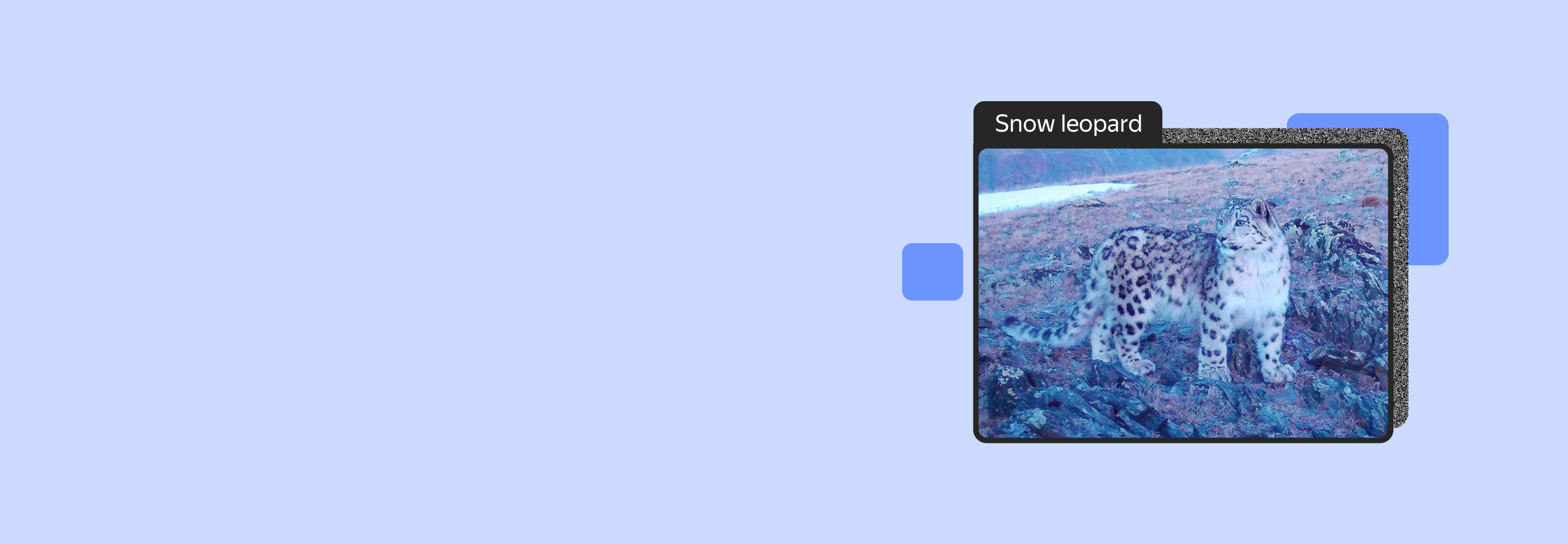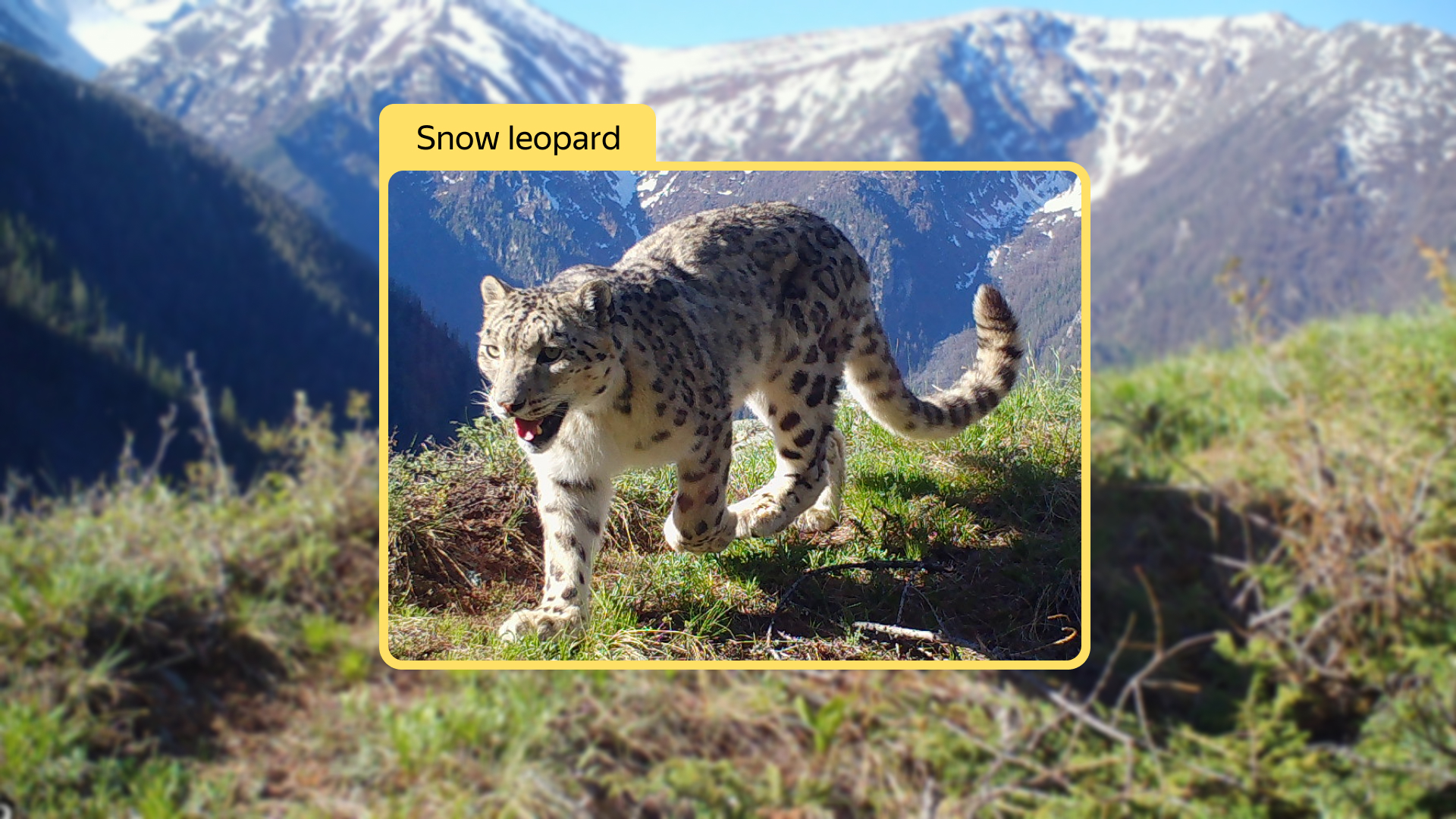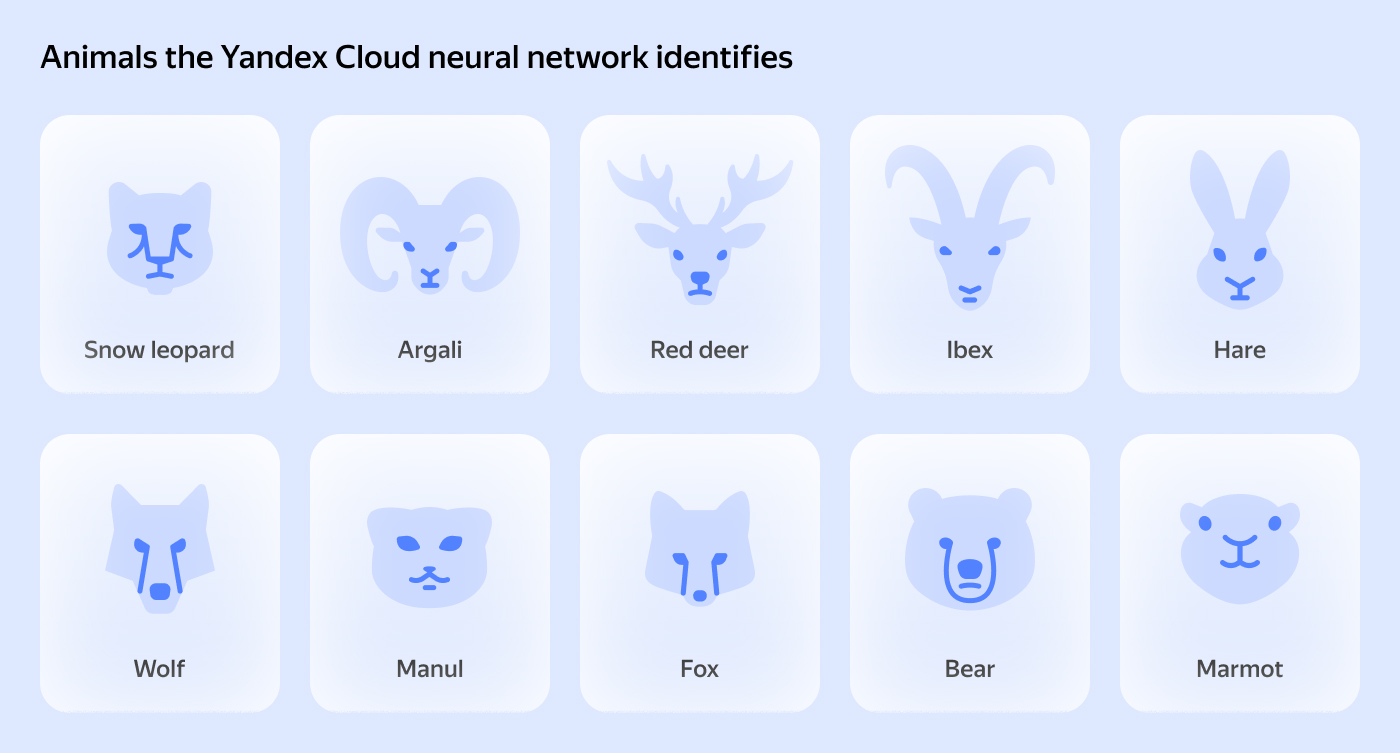In the wild, snow leopards can live up to 13 years.

Saving one species can save an entire ecosystem: Using neural networks to study snow leopards
We created a neural network to process data from camera traps. Denis Malikov, director of the Sailugemsky National Park, and Dmitry Rybalko, architect of ML services at Yandex Cloud, tell us the story of how and why.
The snow leopard is one of the rarest and least studied species of large cats. Also known as the ounce, there are no more than 90 of them left in Russia, with 24 living on the territory of the Sailugemsky National Park in Altai.
The snow leopard is the only large cat that lives at such high mountain altitudes — mostly 2,500 to 3,000 meters above sea level, and sometimes even up to 6,000 meters. Uniquely adapted to such conditions, it is a flexible and graceful animal with a large fluffy tail that helps maintain balance while hunting and also keeps it warm in cold weather.

International Snow Leopard Day has been celebrated since 2013. The participants of the Global Snow Leopard Conservation Forum in Bishkek set the date for October 23. On that day, 10 years ago, the forum introduced a global strategy for the preservation of 20 populations of snow leopard living across a territory of about 500,000 square kilometers.
The snow leopard inhabits only 12 countries with mountain ranges, including Mongolia, Kyrgyzstan, Kazakhstan, Tajikistan, Uzbekistan, China, Nepal, and India.
Less than two percent of snow leopards live in Russia, and they are all located in Siberia — namely, Altai, Tuva, Buryatia, and Krasnoyarsk Krai — though they could potentially live in many more territories in Russia, but their current population numbers make this impossible.
There are between 4,000 and 7,000 snow leopards in the world. For the last few years, Russia has been running qualitative monitoring, however, since snow leopards move between countries, international cooperation is crucial. Some countries lack the appropriate funding or specialists, e.g., there are not enough camera traps or no one to process the relevant images.
Why the snow leopard is in the Red Book
The snow leopard was listed in the International Red Book in 1986. At first, it was listed there as an endangered species. A species is classified as such when there are less than 2,500 individuals left in the world and its numbers have decreased by more than 20% over the last two generations. In 2017, the snow leopard was classified as a vulnerable species, a status that is assigned when there are less than 10 thousand individuals.
Inclusion in the Red Book means that:
-
Hunting this animal is forbidden.
-
The state has adopted special protection policies. In Russia, this is the Snow Leopard Conservation Strategy adopted by the Ministry of Natural Resources and Ecology.
-
There is a monitoring program. In 2021, Russia approved a unified method for the protection and research of snow leopards.
Snow leopards suffer from both natural changes and human actions.
| Threat | What’s happening |
|---|---|
| Poachers | Snow leopards are hunted for their fur, while their kittens are caught and sold to illegal zoos. Snow leopards also die in traps and snares set for other animals. In 2019, Russia strangthened the liability for hunting animals included in the Red Book, with the maximum term of imprisonment increased to eight years. |
| Cattle farmers | Sometimes, cattle farmers kill snow leopards if they attack their cattle. In order to reduce the number of such cases, conservationists suggest compensating farmers for damages. Some regions have already seen this initiative implemented. |
| Climate change | Snow leopards are forced to change habitats as conditions in their former ones can no longer sustain them. For example, if the mountain grasslands shrink, there are fewer hoofed animals, which means less food for them. As a result, the snow leopard moves closer to humans, who pose a bigger threat to its survival. |
| Anthropogenic infrastructure | Roads and industrial facilities are built in former wilderness areas. Snow leopards have to either adapt to the company of humans or look for other territories. |
Snow leopards are given names in order to humanize them. This helps to draw attention to vulnerable species, and is particularly important in the areas where humans coexist with such animals. Sometimes, there are even competitions with a goal to come up with names for local snow leopards. For example, Hook was given this name because of the shape of a spot on its pelt. Another snow leopard was named Artist because of its damaged tail that looked like a paintbrush. Snow leopards are often given Altai names, and sometimes they are even named after Indian gods.


Camera traps can be used to track the life history of an animal. The snow leopards Khan and Guta got caught on camera traps in Altai for 10 years. Most likely, they have kittens together.
How to preserve animals in the Red Book
To preserve a species, you need to study it thoroughly. Snow leopards, however, are exceptionally difficult to study due to their remote locations, nocturnal lifestyle, and their practice of hunting alone.
Specially protected natural areas, including nature reserves and national parks, help most in researching and preserving the species.
To understand where to create such an area, we need to know the habitats and number of specimens. There are several approaches:
-
Tracking on the trail: People often find traces of snow leopard and record their number and coordinates. This method is not always valid, as snow leopard footprints can be confused with traces of lynx, wolverine, or other animals.
-
Studying traces of activity: Snow leopards mark stones and rocks, so you can determine their habitat by the excrement left and even by smell. It is also possible to tell if there was an snow leopard in the area by the claw marks on the trees and dirt swabs.
-
Camera trap monitoring: Camera traps should be installed on animal trails, ideally two per 5 square kilometers.
-
Molecular genetic analysis: DNA analysis of excrements and fur can determine the sex and species.

Camera traps showed that one of the Altai snow leopards covered 100 km in 2020. This means it was either starving or looking for a female.
The snow leopard is an umbrella species, meaning that it is at the top of the food chain and, like an umbrella, covers the entire ecosystem in which it lives. Likewise, the polar bear is an umbrella species in arctic ecosystems, along with the Amur tiger in the Far East, and the snow leopard in the mountain areas of Central Asia. By preserving the umbrella species, we can protect the entire ecosystem.
How neural networks help identify snow leopards
There are 170 camera traps in the Saylugem national park. Each one can take up to 5,000 pictures, but only 10% to 30% of them are usually relevant. In addition to the animals being studied, a camera may capture passing birds or even just waving grass. It sometimes takes scientists weeks to manually find snow leopards among thousands of images.
Therefore, specific software is needed to automate the recognition of data from camera traps. Similar solutions are already used to monitor plant propagation and conditions in the Lake Baikal ecosystem.

Camera traps are expensive, yet easily damaged by animals, poachers, and avalanches.
Along with the students of the Yandex Data Analysis School, we developed a neural network that processes images from camera traps and detects animals in just a few seconds.
How we trained our neural network
We trained a model on 150 GB of material — over 40,000 photos and video fragments. The Yandex U‑team
We also used pictures without animals for training and quality check. In addition, the employees of the national park wanted to train the neural network on empty photos that did not need to be reviewed.

We used You Only Look Once (YOLO) architecture, one of the most popular for object recognition.
Once we began training, we realized that the model was unable to process nighttime shots, so we made a copy nd fine-tuned it to work with nighttime shots (about 30% of all images). As a result, we got two working models. The pixel script we wrote identifies whether it is day or night in the photo and sends the image to the relevant neural network.
Why we use the cloud in this project
Cloud technology makes it possible to run lots of experiments and quickly train models. Neural networks need large computing capacity, but organizing local infrastructure for them is too expensive.
We’ve got six people working on the project: Dmitry Soshnikov, associate professor at the Higher School of Economics, four students of the Yandex School of Data Analysis, and myself. To make it easier to work on the project with the entire team, we used Yandex DataSphere as our ML development tool. It allows you to conduct team research in the JupyterLab environment, and conveniently share data and run many experiments. Team members don’t need to reconfigure the environment on their own; instead, you can build an image once with all the required libraries and share them with your team.

We use Yandex Object Storage to store photos and video fragments from the national park, while Yandex DataSphere handles data processing and model training. One cycle of neural network training against 10,000 images takes 5 to 6 hours. It takes a lot of these cycles to improve the model’s performance as we highlight the flaws in the current iteration and run a new experiment.
For the national park employees to be able to load images and start recognition in a single click, we deployed a simple application in Yandex Compute Cloud. As a result, the application distributes the pictures into folders according to the animal type.
What’s next
At the next stage, the neural network will learn to identify specific snow leopards in the pictures by distinguishing unique patterns on their fur or by other distinctive parameters. The neural network will also recognize even more animals, for example, the birds and mice that often get caught on camera.
We will increase recognition accuracy, and get additional information from the video about the time it was taken. If the neural network accidentally mistakes one animal for another, then we can use other recognizable footage shot at the same time to determine what is in the photo.
We also want to add visualization to the map. We can locate animals using the time and geolocation of the image. Scientists will be able to collect statistics about park inhabitants, build maps of their favorite places, and study their travel routes.
The neural network can be fine-tuned and used to observe any animal. This will help scientists objectively assess population numbers and develop measures to protect species quickly and based on large amounts of data.

